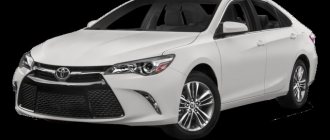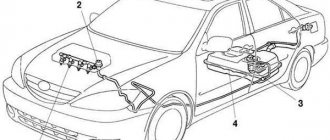5616 Apr 20
Domestic car owners often have no idea what the class of passenger vehicles is and how it is determined, while mistakenly classifying their own car as a more expensive segment. This especially applies to owners of a 2013 Toyota Camry, who decide which class their car belongs to. Many of them consider it a premium car, without going particularly into the official criteria adopted by automakers for determining the type of passenger vehicles.
What class of car does the Toyota Camry belong to?
Domestic car owners often have no idea what the class of passenger vehicles is and how it is determined, while mistakenly classifying their own car as a more expensive segment. This especially applies to owners of a 2013 Toyota Camry, who decide which class their car belongs to. Many of them consider it a premium car, without going particularly into the official criteria adopted by automakers for determining the type of passenger vehicles.
Criteria for choosing the class of passenger vehicles
Modern automakers have adopted a special system that has 9 letter designations in Latin, with the help of which consumers determine what class a particular car has and what segment it belongs to.
The criteria by which the type of model produced by the plant is determined are its weight and size indicators, with the help of which the car is assigned to the following classes:
- “A” - compact city cars, the length and width of which are no more than 3600 and 1600 mm, respectively.
- “B” - it includes models with a length from 3600 and up to 4200 and a body width of 1700 mm, respectively.
- “C” is the lower middle class, or Golf class, which includes cars up to 4400 mm long and up to 1750 mm wide.
- “D” is a full-fledged average type, which includes cars up to 4600 long and up to 1800 wide, respectively, in mm (the most obvious representatives of this class: Audi A4, Mercedes C, Ford Mondeo).
- “E” – called the upper middle segment. This includes car models up to 4900 mm in length (obvious representatives: Toyota Camry, Mercedes E, BMW 5 Series and Audi A6).
- “F” is the executive, or premium, segment, which includes all models of passenger vehicles whose length exceeds 4900 mm (obvious representatives of this segment: Mercedes S, BMW 7 Series, Audi A8).
Other models of passenger vehicles that have non-standard body options are subject to separate classification, namely:
- “S” – sports car segment (typical representatives: Ferrari, Lamborghini, Lotus).
- “M” – multivans and minibuses (such as Mercedes Vito, Volkswagen Transporter).
- “J” class is represented by crossovers and SUVs (Hammer, Chevrolet Tahoe, Toyota Land Cruiser).
Appearance and dimensions of Toyota Camry 2021
Expressive body design is one of the main features of the updated Toyota. It is provided with a chrome grille bar, elegant front optics and LED lights. And also – stylish alloy wheels, a sporty and modern-looking rear bumper, a lacquered black roof and a compact wing. All this makes the car more aggressive in appearance. Although the car still remained recognizable.
The overall dimensions of the vehicle have not changed - even the ground clearance. The length of the updated Toyota still slightly (by 11.5 cm) does not reach 5 meters, the width is 184 cm, the height is 145.5 cm. The wheelbase is 2.825 m, and the weight, depending on the configuration, is from 1.555 to 1. 69 tons.
Second generation (v20, 1986-1991)
Experts traditionally believe that the history of the modern Toyota Camry, as an independent and successful model, takes its origins from the 2nd generation of the car. It is also significant that the car was introduced in 1986 in the business class.
Second generation (v20, 1986-1991)
The first thing that catches your eye is the rounded lines of the body, which gave the vehicle’s exterior a deliberate roughness and massiveness. There is no trace left of the previous design. The model was sold in traditional sedan and station wagon body styles. In addition to the updated design, the car received modern electronics and improved technical solutions:
- 2 liter diesel engine and 1.8-2 liter petrol engine;
- fuel consumption per 100 km varies from 8 to 11 liters for a 2 liter diesel automatic and 2.5 liter petrol automatic, respectively;
- transmission - automatic or manual;
- acceleration to 100 – about 12 s;
- The maximum speed is limited to 165 km/h for a 1.8 liter automatic, in the case of a 2.5 liter manual transmission – 210 km/h.
Second generation front panel (v20, 1986-1991)
All-wheel drive vehicles were available only in the domestic Japanese market; they were delivered abroad on pre-orders.
Toyota Camry class depending on year of manufacture
During the production process, Camry cars were equipped with bodies that differ in size and internal volume. The dimensions of the equipment never fell below the level corresponding to category D. Marketers of the Japanese concern always indicated class E for Camry sedans or station wagons (similar to the premium segment of the Lexus GS), which was the subject of criticism from automotive experts.
XV10
The Camry XV10 generation began production in 1991 for the Japanese domestic market and belonged to the Small size vehicles category (body length up to 4700 mm). In 1993, the company introduced the model to foreign markets (the body differed in size and shape from the Japanese version); in the United States it was classified as a mid-size car. According to European requirements, the car was between groups D and E, but automobile magazines and catalogs classified the Camry XV10 as class D.
Toyota Camry XV10 is a car with a 5-speed gearbox.
XV20
Introduced in August 1996, the XV20 generation had sedan and station wagon body styles. For some markets, long-wheelbase sedan and 2-door coupe versions were offered. Toyota declared compliance with group E, but in Europe the car was assigned category D, and in the USA the equipment was classified as a mid-size vehicle.
Toyota Camry XV20 is the fourth generation of the famous Japanese sedan.
The Camry Solara version with a coupe body with a sporty twist, produced by the Canadian branch of the concern, was also considered a passenger car with medium dimensions.
XV30
In 2001, a new generation of the Camry XV30 was introduced, which did not provide any other bodies other than a 4-door sedan with a length of 4815 mm. The increase in dimensions made it possible to achieve class E compliance, but many automobile publications criticized the equipment for an insufficient level of comfort and equipment that did not correspond to European concepts of business-class cars. The XV30 generation was the last to be offered on the European market; further models were sold in North America, Russia, Southeast Asia and Arab countries.
Toyota Camry XV30 is a 4-door car.
XV40
The XV40 generation, which appeared in 2006, had a body length of 4815 mm, which made it possible to fit into the European framework of category E. The cars were supplied to Russian customers as representatives of the business class, but in terms of equipment and dynamic characteristics, Toyota products were inferior to competitors from Europe (for example, Mercedes- Benz or BMW). The advantage of Japanese cars was the reduced price, which made it possible to occupy a large part of the niche in the Russian market.
Toyota Camry XV40 is a popular Japanese business class sedan.
The deep modernization carried out allowed the production of the new XV50 body to begin in 2012, which underwent restyling in 2014 (the model code changed to XV55). The length of the car for Russia was 4820 mm; for the markets of North America and Southeast Asia, a body with modified bumpers was offered, increasing the dimensions by 30 mm. The vehicle was positioned as a business class sedan, corresponding to category E according to the European rating scale and medium size according to the North American standard.
XV70
In 2021, the production of the XV70 generation started with a sedan body having a length of 4885 mm and a width of 1840 mm. In the US market, the car meets the requirements for medium-sized cars. By European standards, the equipment belongs to category E, but due to the emergence of additional gradations between the main classes, it meets the requirements of E+.
Toyota Camry XV70 is a sales leader, a successful and reliable car.
Grading criteria for passenger cars
A combination of factors will help determine which class a vehicle belongs to. Starting with the price, you should analyze the size of the car, engine power, the quality of materials used in the interior design, whether the car is equipped with various options, as well as the premium quality of the brand. But of these indicators, the main evaluation criteria are size.
Car classes
Passenger cars for the most part are cars of categories A, B, C, D, E and F. Instead of a verbal approximate description, as well as for convenience and a more accurate determination of the size of passenger vehicles, a special gradation was compiled.
Class “A” cars, or city cars, as they are also called, are often preferred by female representatives. Thanks to their miniature size (no more than 3.5 meters in length and a little more than one and a half meters in width), cars of this category move deftly around the city even during rush hour, and take up little space - they are convenient to park. I am pleased with the low fuel consumption.
Category "B". The vehicle is slightly larger in size than a city vehicle. These are often front-wheel drive three- or five-door hatchbacks. The length reaches 4.2 and the width up to 1.7 meters. A small vehicle suitable for transporting medium-heavy items. You can count on satisfactory conditions when driving around the city or leaving its boundaries.
Category “C”, which is also called Golf class, in honor of the model of the same name from the German manufacturer. Practical city vehicles with fast engines and the best equipment. Length up to 4.40 meters, width up to 1.75 meters. Passengers feel more comfortable. These cars have more powerful engines and a larger trunk than the “B” segment.
Class "D". Length up to 4 meters 60 cm, width up to 1 meter 80 cm. Optimal ratio of spacious interior and trunk capacity. A group of five people will feel comfortable on the road.
The first Camry models belonged to this segment.
Category "E" or "business". Length up to four meters and ninety centimeters, width more than a meter, seventy centimeters. Higher quality materials are used in the design. The engine capacity is more than two liters and there is impressive interior space.
The latest generations of Camry are in this category.
Class "F". The length is over four meters and ninety centimeters, the width is from a meter, seventy centimeters. Category of luxury cars. The exterior and interior emphasize the luxury level. Particular attention is paid to the comfortable stay of passengers in the rear seats.
Toyota Camry is often called a “business” class car for its high level of comfort.
Varieties of car classes.
At the moment, all major concerns have decided to introduce a special letter designation system of 9 Latin characters, which will designate classes of passenger cars. This will allow the consumer to determine which segment a particular car belongs to and help in choosing a new model.
The main determining criteria are the weight and dimensions of the vehicle. In accordance with this, the following division has been adopted:
- "A" - compact city cars. Length up to 3600mm, width no more than 1600mm.
- “B” - this includes cars with a body length of up to 3600 mm and a width of up to 1700 mm.
- "C" - lower middle class. Length up to 4400mm and width up to 1750mm. It is also called “Golf Class”, after the most popular model in this segment. This also includes Ford Focus and Toyota Corolla.
- "D" - Average type of car. The length of the car is up to 4600mm and the width is no more than 1800mm. This includes: Audi A4, Mercedes S, Ford Mondeo.
- "E" - Upper middle segment. This includes all cars with a body length of no more than 4900mm. The most typical representatives of this class are Toyota Camry, Mercedes E, BMW 5 Series, Audi A6.
- "F" - Premium segment. It includes passenger car models with a body length of 4900 mm or more. This group includes Mercedes S, BMW 7 Series, Audi A8.
Some models are also identified in separate groups that have non-standard body parameters and length-to-width ratios.
- “S” - A group that includes all sports cars, such as Lamborghini, Ferrari, Lotus.
- "M" - Minibuses. Example - Toyota Alphard, Volkswagen Transporter.
- “J” - SUVs and crossovers (SUVs). The most typical representatives are Land Cruiser and Toyota RAV4.
Very expensive and very liquid: a guide to buying Toyota Camry VII
I won't surprise anyone by saying that the Camry is an amazing car. Simple, and in some places even simple, but always popular, amazingly expensive and always liquid on the secondary market. The seventh generation fully corresponds to all these descriptions: having appeared in 2011, it inherited from its grandmother with the XV30 index not only the platform, but also the base engine, while receiving a portion of evolutionary changes. Do you think this had any impact on sales? It’s only positive: Camry consistently ranked in the top 20 most popular models on the Russian market and, for example, in 2021 overtook not only Volkswagen Tiguan and Kia Sportage, but also Lada 4×4, Renault Logan and Chevrolet Niva. Even the Koreans with their Sonata and Optima could not keep up with its results. And six-year-old cars are now being sold for the same money they were sold for new. Although in the case of Toyota this is not surprising. Let's delve a little deeper into this mild craze and see what budget you should approach when buying a Camry, whether there are regions in which it is unpopular, and what you will generally have to face when searching.
How much does the normal option cost?
Camry remained true to its ideals: naturally aspirated engines, classic automatic transmissions and a consistent image drove sales even when strong currency fluctuations began to reshape prices. It did not require any all-wheel drive, like the Nissan Teana, or turbo engines, like the Volkswagen Passat - the Japanese were already steadily collecting banknotes from private buyers, corporate clients, large taxi companies and government tenders, sometimes throwing a couple of logs into the regularly blazing fire in the form of special versions. About 30 thousand cars were always sold per year. At the same time, Camry’s liquidity keeps the secondary market in good shape: there are about 3 thousand cars on sale, which is a lot, but not very much, especially considering the high prices for used copies. After all, as it turns out, without a million you still can’t approach the previous generation Camry.
Body and dimensions of Toyota Camry
The Camry XV70 ditched the old chassis in favor of the new one on which the latest Prius was built. The wheelbase of the flagship has increased, but the car itself has become closer to the ground, its height is 1.45 cm. The roof line is sloping, and since the car has become lower, the driver’s position behind the wheel is also lower. The seating position is comparable to that of a sports car.
While working on the external appearance of the XV70, the designers made a kind of flashback to the dynamic silhouette of the XV40 body. There, just like the new Camry, there were slanted headlights and narrow taillights. The front and rear lights in the new version will be available as halogen in simple trim levels, and fully LED in the three top versions.
In our case, we are testing the maximum Prestige Safety package for a 2.5-liter engine, costing 1,930,000 rubles; this version has LEDs.
Look at this massive radiator grille, it wasn’t small before, but now its architecture screams about its audacity. No, we don’t want to sing defamations to Toyota’s creation, but the new Toyota Camry really turned out to be very beautiful.
Perfected aerodynamics and enlarged wheel arches once again hint to us that this business sedan has now acquired sporting habits. Basic versions are equipped with 16-inch wheels, top versions come with large 18-inch wheels.
The Camry business sedan is loved by both respected gentlemen from the government and ordinary people who choose the quality and solid appearance of a car. Another advantage of the Toyota Camry is the fact that the price starts at 1,399,000 rubles, and the package with all the necessary functions for life will cost 1,549,000 rubles. Camry is the size of E-class cars, but it costs moderate money.
By the way, Toyota Camry will stand on a par with such competitors as KIA Optima, Hyundai Sonata and Mazda6.
KIA Optima 2.0 Comfort costs 1,329,900 rubles, Toyota Camry will be more expensive in the database, 1,399,000 rubles. The price tag of the Camry is higher due to the fact that the equipment in terms of safety and auxiliary systems is richer than that of the Korean, and the Japanese will already have a separate climate.
Hyundai Sonata 2.0 automatic in the Primary configuration is even cheaper - 1,275,000 rubles, but it is completely empty, and again Hyundai - Toyota, Hyundai - Toyota.
Mazda6 1,336,000 rubles and this is perhaps the only real competitor, but the Camry will have more systems, the Mazda6 only has ESP and ABS in its arsenal. It turns out that the Camry is slightly more expensive, but is much better equipped than the others.
Specifications
The length/width/height/wheelbase of the Toyota Camry 2021 is 4885/1840/1455/2825 mm, and the Toyota Corolla 2021 is 4630/1780/1435/2700 mm, which is smaller in all dimensions. The Camry's ground clearance is 155 mm versus 150 mm for its opponent. The curb weight, of course, is greater for the business class sedan: 1555-1700 kg vs 1370-1440 kg (depending on the modification). The volume of the fuel tank is significantly smaller in the Corolla: 50 liters versus 60 for its rival, and the luggage compartment, on the contrary, is 470 liters versus 493 liters.
Toyota Camry engine
The engine line includes a 2-liter engine with 150 horsepower and a 2.5-liter engine with 181 horsepower. These two engines work with the old 6-speed automatic, but it has been modified. Plus they added a new unit with a volume of 3.5 liters and a power of 249 hp. The new engine is paired with an equally new 8-speed torque converter automatic.
In addition to the notable design work and completely new appearance of the Toyota Camry, the engineers, as we have already said, moved to the new TNGA platform, which ensured an increase in body rigidity by more than 60%.
Toyota made the center of gravity as low as possible, which ensured excellent handling, stability and gave even more driving pleasure.
What is the difference between the St. Petersburg Camry assembly and the Japanese one?
For an unprepared buyer, determining the country of production only by appearance will be extremely problematic. However, if you know where to look, it will become a matter of, if not a few seconds, then at most one minute.
You need to understand that the main components and assemblies, which include body hardware, are supplied to the Russian plant directly from Japan. At the “domestic” plant, only the future machine is assembled from ready-made parts. But there are parts whose production was successfully launched in Russia, which means that the marking of these elements will be slightly different from the original one. Such details include:
- Tires. Japanese assemblies of this model were equipped with tires from Yokohama, while the manufacturer decided to install Michelin tires produced at the company’s plant near Moscow on Russian cars.
- Passenger seats. These interior parts are produced directly at the plant on the basis of the production facilities of one of the subsidiaries. It must be said that the build quality, appearance, upholstery colors and general design of the seats are no different from those that were released in Japan.
- Glazing. For “domestic” Camrys, glass production is established at the Bor Glass Factory, so their labeling is slightly different from the Japanese one.
However, the above methods for identifying the country of manufacture cannot guarantee the correctness of its determination, because glass and tires can be replaced with others, and the seats are no different at all. To more accurately determine the country of assembly, it is better to use one of the following methods:On those bodies that were manufactured specifically for assembly in Russia, the VIN code begins with the letter “X,” while for Japanese ones it starts with “J.” You will no longer see any other evidence under the hood that the car was not assembled in Japan.
Presence/absence of an eye for attaching a safety rope.
Since the vehicles were transported from Japan to Russia by sea, the manufacturer provided a special eyelet under the rear bumper, to which a safety rope was attached to secure the vehicle on the deck of the ship. If there is such an eye, then you can confidently say that in front of you is a purebred Japanese, because the Russian version of the Toyota Camry simply does not need such a hook.
Whose Toyota Camry build is better?
To fully understand the picture, it must be said that Toyota Camry adapted for Russia was delivered from the “Land of the Rising Sun” only until the end of 2007, and all subsequent models are guaranteed to be assembled at the production facilities of the new plant in St. Petersburg. That is why studying the differences between the Japanese and Russian assemblies is appropriate only for Camry in the XV40 body produced before 2007.
Earlier we said that the manufacturer assured potential buyers that there was no difference in the quality of “Japanese” and “Russian” assemblies. We can say that Toyota management kept its word, because the quality of the final product is truly at the highest level.
The only thing that can give away the car’s country of origin while driving is the slightly noisier and harsher Russian-made Michelin tires. But directional stability at high speeds, as well as comfort on not the best domestic roads, tires of both types provide at a more than adequate level.
Also, some owners are concerned about the paintwork, which is why the Camry assembled near St. Petersburg is supposedly more prone to chipping and, accordingly, the appearance of pockets of corrosion. However, reliable data that can somehow confirm this theory has not yet been found.
In all other respects, the quality of cars assembled in Russia is in no way inferior to Japanese ones. Dynamic qualities, sound insulation, handling, finishing materials and interior equipment are similar to the overseas representatives of the model. Such a large automaker as Toyota simply cannot afford to damage its reputation by producing low-quality cars, so it is very sensitive to the quality of each car produced, regardless of the country in which the assembly line is located.
Which assembly is better to buy?
As paradoxical as it may seem, if you are considering buying a Camry in the XV40 body, then you better take a closer look at the Japanese assembly of this car, even though there is practically no difference between them. The thing is that a large number of our compatriots have not believed in the quality of Russian products for a long time. Moreover, the thought “if it’s Russian means it’s bad” has stuck in our heads so much that it no longer matters who exactly oversees the production. For this reason, you may have difficulty selling your car later. If you are not afraid of the possibility of problems with the sale, then you can safely buy a Russian-assembled Camry. Believe me, you will not feel any difference, but only if the car was properly cared for by the previous owners.











